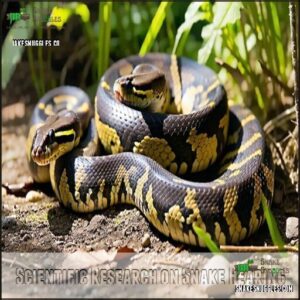This site is supported by our readers. We may earn a commission, at no cost to you, if you purchase through links.
 Yes, ball pythons can hear sound, but not in the way you do. They don’t have external ears, so instead, they sense vibrations through their jawbones.
Yes, ball pythons can hear sound, but not in the way you do. They don’t have external ears, so instead, they sense vibrations through their jawbones.
These vibrations travel to their inner ear, which helps them detect low-frequency sounds, typically between 80 and 1,000 Hz. Think of it like feeling the bass at a concert—you might not “hear” it, but you know it’s there!
They rely on this unique ability to sense predators or prey nearby. While they’re not great at picking up airborne sounds, ground-borne vibrations are their jam.
Curious how this affects their behavior? Stick around for fascinating details.
Table Of Contents
- Key Takeaways
- Can Ball Pythons Hear Sound?
- Anatomy of Ball Python Hearing
- Ball Python Sensitivity to Sound
- Scientific Research on Snake Hearing
- Tips for Ball Python Owners and Handlers
- Implications for Snake Behavior
- Frequently Asked Questions (FAQs)
- Can ball pythons hear?
- Do ball pythons have ears?
- Do ball pythons make noise?
- Do ball pythons have vocal cords?
- How does a ball python ear work?
- Why do ball pythons Hiss?
- Can snakes hear you talk to them?
- Are pythons sensitive to sound?
- Will noise keep snakes away?
- Should I be able to hear my ball python breathing?
- Conclusion
Key Takeaways
- Ball pythons don’t have external ears but sense low-frequency vibrations (80–1,000 Hz) through their jawbones.
- They’re great at detecting groundborne vibrations, making them highly alert to nearby movement or threats.
- Loud or sudden vibrations can stress them, so keep their habitat quiet and away from vibration-heavy areas.
- They rely on vibrations, not airborne sounds, to understand their surroundings and detect predators or prey.
Can Ball Pythons Hear Sound?

You might think ball pythons are completely deaf, but that’s not entirely true.
While they don’t hear like you do, they’re great at picking up low-frequency sounds and vibrations.
Debunking The Myth of Deaf Snakes
Contrary to popular belief, snakes aren’t deaf—they just hear differently. Ball pythons rely on their jaw and skull bones to pick up vibrations from their surroundings. Think of their hearing as finely tuned to detect the rumble of the earth below.
Ball pythons don’t hear like us—they feel sound through vibrations, sensing the world with their jawbones and skull.
Here’s how their snake auditory system works:
- They sense vibrational sound myths, not airborne clarity.
- Acoustic sensitivity limits them to low-frequency ranges.
- Deafness misconceptions arise from their lack of visible ears.
- Vibrations signal sound response behaviors for survival.
- Ball python hearing is nature’s adaptation masterpiece.
- Their ability to detect low-pitched vibrations makes them especially attuned to environmental cues.
Snakes’ Auditory Abilities in Detail
A snake’s auditory system is fascinating, blending subtle mechanics with evolutionary brilliance. Your ball python "hears" mainly through its jaw, detecting vibrations instead of typical sounds.
Here’s the breakdown:
- Frequency Sensitivity: Ball pythons excel at low-pitched sounds (80-160 Hz), like deep vibrations or soft rumbles.
- Low Pitch Detection: Vibrations travel through the jawbone into the inner ear, triggering neural signals.
- Vibration Pathways: The quadrate bone acts like a microphone, channeling ground-borne vibrations.
- Sensory Integration: Airborne sound is limited; snakes evolved to favor ground vibrations.
Understanding these unique traits guarantees proper care for this incredible snake.
Importance of Vibration Detection
Ball pythons don’t hear like us, but their vibration detection system is outstanding.
They use ground-vibration cues to sense the world, relying on low-frequency vibration sensing through their jaws.
This built-in predator detection mechanism alerts them to nearby threats or movements.
Their vibrational sensitivity even aids in terrain navigation signals, helping them move safely.
By processing groundborne vibrations, they achieve survival via vibrations, staying one step ahead in a world where every subtle shift matters.
Anatomy of Ball Python Hearing
You might think snakes can’t hear without ears, but their hearing works in a surprisingly clever way.
Ball pythons rely on sensitive jawbones and inner ear structures to pick up vibrations and process sounds.
Ball pythons
Absence of External Ear Structures
Ever noticed how ball pythons lack visible ears? Their heads showcase fascinating Sensory Evolution Insights with no outer ears or eardrums in sight. Instead, their reptile ear anatomy has adapted for Natural Sound Transmission differently.
Here’s why their python auditory system stands out:
- No external ear openings mean no traditional eardrum structures.
- The Quadrate Bone Function transmits vibrations internally.
- A smooth head shape aids in streamlined Skull Vibration Mechanics.
- Specialized ball python inner ear structures turn vibrations into detectable signals.
These snakes have mastered Unique Hearing Adaptations, using their heads as sound-sensing tools!
Role of Jaw Bones in Vibration Detection
Your ball python’s jawbone vibratory mechanism is a masterpiece of evolution.
When its jaw touches the ground, vibrations travel through the jawbone vibrations to the quadrate bone, which acts like a relay station.
This triggers the columella vibration pathway, sending signals to the brain for processing.
These evolutionary jaw adaptations make the snake’s vibration sensitivity finely tuned for detecting nearby movements or predator threats with pinpoint precision.
Inner Ear Structures and Auditory Nerves
Your python’s inner ear is a finely tuned vibration detection masterpiece.
Unlike mammals, they lack a tympanic membrane, relying instead on the quadrate bone to transmit vibrations. These vibrations pass to fluid-filled chambers in the inner ear, triggering cochlea nerve impulses.
Nerve signal processing travels via the vestibulocochlear nerve to the brain.
Here’s how their python ear structure excels:
- Vibration Transmission Pathways guarantee low-frequency detection.
- Cochlear Function Analysis converts signals for interpretation.
- Quadrate Bone Role connects vibrations to inner ear structures.
- Fluid Chamber Mechanics process vibrations seamlessly.
- Nerve Signal Processing makes environmental cues understandable.
Ball Python Sensitivity to Sound
You might think ball pythons can’t hear much, but they’re surprisingly attuned to low-frequency vibrations.
While high-pitched sounds are out of their range, they excel at picking up vibrations through their jawbones and skull.
Response to Low-Frequency Vibrations
Nature has gifted these snakes with remarkable vibration detection mechanisms, allowing them to sense low-frequency sounds (80-1000 Hz) through the ground.
They respond best to substrate vibrations below 400 Hz, detecting nearby movement like a natural seismic detector.
Here’s a breakdown:
Frequency (Hz) Sensitivity
Limited Airborne Sound Detection
Hearing in snakes like ball pythons is more about feeling vibrations than crisp sound recognition.
Their airborne sound sensitivity is limited, detecting frequencies between 80–1,000 Hz.
They’re better at picking up low-pitch sound perception, especially those causing strong vibrations.
Unlike how we hear, the snake hearing mechanism processes even muffled tones as faint tremors.
So, can snakes hear? Kind of—but for them, sound vs. vibration often feels like the same thing.
Notably, their hearing range limitations make them most sensitive to low-pitched sounds between 80 and 160 Hz.
Reliance on Other Senses for Navigation
In the process of exploring their world, ball pythons rely on a powerful combination of senses that work together like specialized tools.
As they go about their environment, they excel in other areas, making them masters of sensory adaptation.
- Thermal Imaging: Their heat-sensing pits act like night vision goggles, detecting even tiny temperature changes.
- Chemical Cues: That famous forked tongue samples the air, delivering data to the Jacobson’s organ for scent analysis.
- Tactile Sensing: Through snake vibration detection, they pick up substrate vibrations and groundborne signals, staying alert to their environment.
- Spatial Memory: Visual cues help them interpret light, movement, and landmarks.
These finely tuned ball python senses let them thrive, even in low-light or sound-limited conditions.
Scientific Research on Snake Hearing
You might be surprised to learn that scientists have studied how snakes like ball pythons sense sound and vibrations.
Research shows they rely heavily on ground-borne vibrations, using specialized anatomy to interpret their surroundings.
Studies on Snakes’ Auditory Abilities
Research into snake auditory capabilities reveals their frequency detection range peaks at 200-300 Hz, ideal for sensing low-pitched sounds.
Auditory research advances highlight how ball pythons process sound through vibrational sensitivity mechanisms, utilizing the cochlea within their specialized inner ear.
These studies uncover the fascinating snake auditory capability, proving they’re not "deaf." Instead, snake hearing evolution focuses on survival needs over crisp sound clarity.
Ball Pythons’ Sensitivity to Ground-Borne Vibrations
Think of your ball python as a living seismograph, built to sense the world through ground vibrations with amazing precision. Vibrational sensitivity mechanisms let them detect even faint tremors, especially those below 400 Hz. This low-frequency vibration sensing plays a major role in keeping them alert to their surroundings.
Here’s what drives their exceptional ground vibration detection:
- Their jawbones, in constant contact with surfaces, act like natural vibration microphones, sensing ground vibrations effortlessly.
- The quadrate bone captures these signals, transmitting them to an intricate inner ear system that processes vibrations into nerve signals.
- Their whole body amplifies substrate interaction effects, enhancing detection of nearby movement.
Snake habitat vibrations are a daily narrative for your python, keeping it aware, calm—or, sometimes, stressed.
Importance of Substrate-Borne Vibrations
Ball pythons rely on substrate-borne vibrations to make sense of their world. Snakes perceive sound through jawbone vibration detection.
Their jawbones, especially the quadrate bone, act like vibration antennas, detecting low-frequency waves for predator detection, prey location, and terrain navigation.
Here’s how these silent cues work:
| Sense | Frequency Range | Purpose |
|---|---|---|
| Vibration | 80-1000 Hz | Detects predators/prey |
| Airborne | Limited | Minimal environmental input |
| Ground | Below 400 Hz | Maximizes environmental awareness |
This reptile vibration sensing keeps them safe and aware!
Tips for Ball Python Owners and Handlers
When caring for a ball python, it’s important to understand how sensitive they’re to vibrations and low-frequency sounds.
Creating a calm, quiet environment can help reduce stress and keep your snake healthy and comfortable.
Creating a Calm Environment
Creating a calm habitat helps your ball python feel at ease. Their sensitivity to vibrations makes enclosure soundproofing key.
Use these stress reduction techniques:
- Pick a noise-free placement away from TVs, washing machines, or loud devices.
- Use a soft substrate for gentle vibratory enrichment.
- Keep the enclosure in a consistent, quiet area.
- Incorporate cozy hides and climbing structures.
- Limit high-traffic areas nearby for environmental awareness in snakes.
- Avoid placing them near foot traffic.
- Provide stable temperatures.
- Make certain sound perception isn’t overstimulated with sudden noise.
- Opt for calm habitat design that prioritizes snake sound sensitivity.
For additional peace of mind, consider investing in specialized soundproofing materials to reduce vibrations and noise impacting your snake’s environment.
Avoiding Sudden Loud Sounds
Ball pythons may not hear like humans, but they’re sensitive to vibrations and low-frequency sounds, making sudden noises a potential stress trigger. To create a peaceful environment, move their enclosure away from speakers, washing machines, or other vibration-heavy devices. Sudden sound effects like slamming doors or loud footsteps can disrupt their calm, so keep noise minimal around them.
For managing vibrational noise, place their habitat on a sturdy, stable surface. Noise-free habitats benefit from sound-dampening materials nearby, reducing vibrations that could alarm your snake. Using vibration dampening materials can further absorb disruptive vibrations and provide a more tranquil setting for their enclosure.
If you enjoy music, prioritize calm enclosure practices—keep bass tones low to avoid overwhelming their sound detection.
When handling, use smooth, predictable movements. These stress reduction strategies help them feel secure. After all, sound perception in ball pythons relies more on subtle vibrations than airborne noise.
Monitoring for Stress and Anxiety
Loud sounds and vibrations can lead to stress in ball pythons. Look for these stress indicators:
- Rapid tongue flicking or defensive strikes during handling.
- Refusal to eat or irregular feeding habits.
- Excessive hiding, especially when typically active.
- Restless pacing or repetitive movements in the enclosure.
- Aggressive hissing despite their usual calm behavior.
Reducing stress from noise involves environmental adjustments like keeping the habitat calm. Ball pythons rely on vibrational sensitivity, so their sound perception in captivity requires thoughtful care to guarantee their comfort.
Stress can also result in physical signs like regurgitation or breathing problems, which should be addressed promptly.
Implications for Snake Behavior
You might think ball pythons ignore sound, but their unique hearing abilities play a key role in their behavior.
They rely on vibration detection to sense predators, navigate their surroundings, and respond appropriately to threats.
Evolutionary Pressures and Snake Behavior
Millions of years of survival adaptations have refined ball pythons’ vibrational sensitivity, enhancing predator avoidance strategies and aiding behavioral stress responses.
Their reliance on vibration, funneled through the quadrate bone, reflects vibrational sensory evolution.
Different species adapt based on habitat—some snakes approach vibrations, others flee.
This evolutionary hearing role highlights their stealthy predation style. Snake hearing isn’t about communication; it’s about sensing predators and prey.
Such unique capabilities underline the fascinating link between survival and evolutionary adaptation.
Importance of Further Research on Snake Navigation
There’s a lot left to learn about how ball pythons find their way around, and researchers think cracking the mystery of how snakes process vibrations could reveal answers.
It’s clear that vibration sensitivity plays a massive role in their survival, but what about understanding behaviors like movement or hunting? Scientists are on it.
Here’s what ongoing studies focus on:
- Advancements in Sensory Mapping – By analyzing how pythons perceive vibrations, researchers can create enclosures mimicking nature’s cues, improving habitats.
- Research on Movement Patterns – Exploring how snakes detect and respond to vibrational signals reveals insights into their migration and territorial habits.
- Navigation Through Vibrations – Snakes likely detect environmental cues like prey or obstacles through vibratory information.
Understanding python hearing range and snake sound perception will guide better care and deepen appreciation for these fascinating, silent navigators.
Frequently Asked Questions (FAQs)
Can ball pythons hear?
You might think ball pythons are deaf, but they’re good at picking up low-frequency sounds and vibrations.
They sense these through their jawbones, detecting nearby movement or threats rather than overhearing conversations or music.
Do ball pythons have ears?
No, ball pythons don’t have external ears or eardrums like humans.
Instead, they rely on vibrations transmitted through their skull and jawbones, allowing them to "hear" low-frequency sounds and detect movement effectively.
Do ball pythons make noise?
Think of ball pythons as silent observers; they don’t vocalize like mammals.
Instead, they hiss when threatened or stressed. This isn’t speech—it’s a defense mechanism to warn predators or express discomfort in certain situations.
Do ball pythons have vocal cords?
No, ball pythons don’t have vocal cords, so they can’t produce typical vocal sounds.
Instead, they rely on behaviors like hissing or body movements to communicate or warn predators, using vibrations as their primary sensory tool.
How does a ball python ear work?
Ball python ears excel in sensing subtle vibrations through their jawbones.
Vibrations travel to the inner ear via the quadrate bone, where specialized structures convert them into signals.
It’s fascinating yet functional, like nature’s seismic sensor!
Why do ball pythons Hiss?
When a ball python hisses, it’s likely feeling threatened or stressed.
Hissing serves as a warning to potential threats, signaling discomfort or defense.
It’s their way of saying, “Back off!” without striking.
Can snakes hear you talk to them?
Imagine whispering to a rock that feels your words as ripples—snakes hear kind of like that.
They don’t hear you clearly but catch the low, rumbly vibrations of your voice through their jawbones.
Are pythons sensitive to sound?
Pythons are sensitive to low-frequency sounds and vibrations, detecting them through their skull and jaw.
They can’t hear high-pitched noises like human speech but pick up bass tones or movement nearby with impressive accuracy.
Will noise keep snakes away?
Noise, especially loud or low-frequency sounds, might annoy snakes but won’t reliably keep them away.
Their sensitivity to ground vibrations means they might detect and avoid persistent disturbances, but it’s not a foolproof deterrent.
Should I be able to hear my ball python breathing?
When your ball python breathes, you might catch a soft, barely-there whistle or puff, especially during stress or shedding.
Normal breathing is nearly silent, but any frequent wheezing could signal a respiratory issue.
Conclusion
Understanding ball pythons’ hearing is like piecing together a puzzle—they sense the world differently.
While they can’t hear airborne sounds like we do, their ability to detect low-frequency vibrations through their jawbones helps them navigate their environment and sense threats or prey.
By appreciating how ball pythons hear sound, you can create a calm habitat, avoid vibrations that might stress them, and deepen your connection with these fascinating creatures.
Their unique senses truly set them apart.















